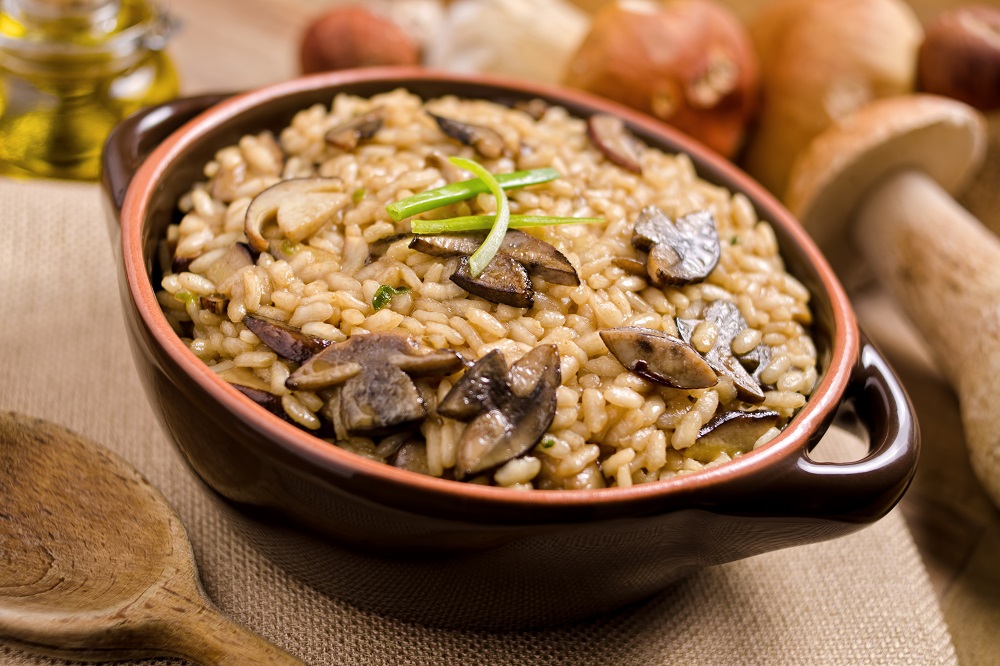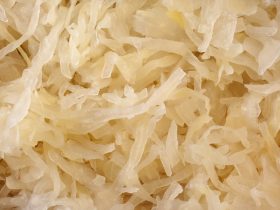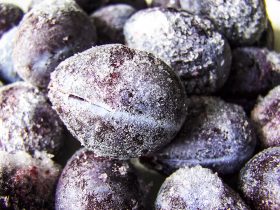Risotto, traditionally, is an Italian rice dish boiled to the consistency of porridge. Records of risotto being cooked in Milan go back as far as the early 1800s1. Owing to the nature of how the rice in risotto is prepared, a large amount of water and broth proteins are absorbed, providing the perfect bed for bacterial growth.
In order to avoid this, it is best to freeze or refrigerate risotto, especially if cooked in larger than single-serving batches.
As risotto is highly likely to develop microorganism colonies, it is advisable that you keep it refrigerated for only a few days, depending on the ingredients used. Should you wish to store the risotto for longer periods, however, it is best to freeze it.
The caveat here is that freezing risotto has a hardening effect on the cooked rice grains, and particular methods must be followed in order to thaw them.
Can You Leave Risotto Out?
Shortly after finishing cooking risotto, bacterial spores will begin to develop into full-grown colonies as the food cools to a more habitable temperature. According to the National Health Services of the United Kingdom, bacteria can form colonies in as short a time span as one hour2.

If your risotto has been left out in the open for more than two hours, it is best to investigate whether it is safe for consumption first.
How Long Does Risotto Last in the Fridge?
The most preferable option for short-term storage, refrigerating your risotto is simple and requires very little equipment.
After cooking, allow to cool for twenty minutes before placing in an air-tight container for up to five days. Keep in mind that if the risotto incorporates other ingredients with a shorter or more volatile shelf-life than the risotto itself, it will only last as long as these ingredients.
Refrigerating risotto will also cause it to thicken as the saccharides present within the dish bind at a molecular level in the presence of cold. This may be remedied by using the proper reheating procedures found later in this article.
Why Does Risotto Go Bad so Fast?
Risotto, being a primarily carbohydrate-based dish boiled in amino-acid rich broth, acts as the ideal food source for a multitude of bacteria and fungi. As such, the only true way to slow down the eventual colonization of these life forms is either by killing them with heat, or slowing down their biological functions through cold.
Freezing the Risotto
Please note that this applies to risotto that has been freshly cooked, as older risotto may prove unpredictable to store.
After cooking, spread the risotto evenly across a lined baking tray so as to cool it as quickly as possible. Do not leave the risotto outside for more than an hour because it may develop bacterial cultures.
Once sufficiently cooled, simply spoon the risotto into your freezer-safe containers, leaving approximately one inch of space between the risotto and the lid of the container. Ensure that the container is sufficiently clean so as not to compromise the risotto.
After these simple steps, all that is needed is to place the container within the freezer. In the ideal conditions, risotto stored in this way can last for up to ninety days.
Equipment Required to Freeze Risotto
While cooking risotto alone is labor intensive, storing them is relatively simpler and requires far less attention. The only equipment needed to prepare your risotto for freezing is a lined baking tray, rigid freezer-safe containers and a spoon.
Thawing the Risotto
While freezing freshly cooked risotto is easy, it is reheating the dish that proves most difficult. Following improper procedure could cause the risotto to become soupy, or, on the other end of the spectrum, to become hard and dry.
The first step to reheating previously frozen risotto is to take the container and move it to the fridge, leaving overnight or for eight hours at the least.
Once sufficiently thawed, bring a proportionately-small amount of broth to boil before lowering the heat and covering. Place the risotto in the broth and remove the cover, allowing excess moisture to steam out of the pot.
Aggregate the rice gently with a spoon, taking care not to stir it too violently, as this will damage the rice further, affecting its texture. After several minutes, remove from the heat and serve immediately.
Refreezing Risotto
Should you have removed too much risotto from the freezer and now wish to refreeze it, consider refrigerating the left-overs instead.
While the exact chemical process occurring within rice is better discussed below, it should be kept in mind that freezing risotto even once both compromises its texture. Doing so twice may prove disastrous from a quality standpoint.
Apart from this point, there is also the issue of exposure to further microbiological contamination. The heat and added moisture from reheating your risotto will have encouraged any bacteria present in the risotto to accelerate their growth.
If you have instead chosen to refrigerate your reheated risotto, it is best to consume it within a day, and to ascertain that the dish shows no signs of spoilage.
What Does Freezing Do to Risotto?
As it is important to first allow the freshly cooked risotto to cool before preparing it for freezing, water content is lost as it evaporates from the still-present heat. This factor, combined with the additional loss of moisture from reheating and thawing the rice cause a marked toughening of the risotto.
Apart from the loss in water, carbohydrates or in particular starches, undergo a chemical process known as retrogradation when exposed to cold temperatures for extended periods of time3. The effect this has on food is that its texture grows chewier, thickening into a gel-like consistency.
Even if utilizing proper reheating techniques, this retrogradation of starches is mostly unavoidable, as the starches rearrange themselves into a crystalline structure at the molecular level. Sufficiently high enough heat may break these intermolecular bonds, though this would compromise the physical integrity of the dish.
References
1. Roberto Perron. (January 2011). La fabbrica del Duomo e l’invenzione del risotto. Corriere della Sera
2. Unknown author. (March 2020) Can reheating rice cause food poisoning? National Health Services https://www.nhs.uk/common-health-questions/food-and-diet/can-reheating-rice-cause-food-poisoning/
3. Jenkins, P J, and A M. Donald. “Gelatinisation of Starch: a Combined Saxs/waxs/dsc and Sans Study.” Carbohydrate Research.





Hi, I'm Dom
Dom Eats was started to help other people fall in love with food. While cooking can feel intimidating, it doesn't have to be.